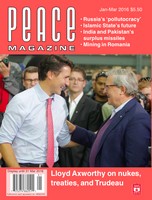
Peace Magazine Jan-Mar 2016, page 29. Some rights reserved.
Search for other articles by Edward Silva here
By D.R. Simon. San Francisco: Red Wheel, 2013.
David Robinson Simon is a former corporate lawyer turned progressive political economist. He has written an oddly titled critique of the American meat industries. Meat is defined broadly as beef, sheep, pig, fowl, dairy, eggs, as well as fish and seafood.
The book is divided into three parts. The first deals with influencing the consumer. For example, he notes that meat producer trade associations and the US Department of Agriculture fund aggressive marketing programs urging the unhealthy overeating of meat (as defined above).
Further, at the legislative level, the meat manufacturers have shaped laws in the industries’ interests, permitting routine cruelty and the gagging of civil society criticisms of animal production.
Finally, the meat industries have effectively captured many of the regulatory organizations, like the state and federal food and drug agencies. Thus, if the odd progressive law does pass, the agencies fail to rigorously enforce it, rendering these laws, rules, and regulations inoperative and largely symbolic.
The second part of the book estimates the “hidden costs” of meat. One of these costs, hospital care, is conservatively estimated as more than $300 billion, mainly heart diseases, diabetes, and cancers. Another “externalized” cost involves the environment and such things as soil erosion, manure remediation and chemical run-off. These total an estimated $37 billion annually. Simon also estimates the US fish industry externalizes at least $4.5 billion annually in by-catch, fish farming, and overfishing.
Then, there are government subsidies, often as direct grants to the meat industries’ trade associations.These amount to some $38 billion per year.
Adding up these externalized costs and state subsidies and adding in a few more, Simon comes up with annual figure of $414.8 billion. This number suggests the annual size of meat market failure in the USA.
Happily, Simon also offers some solutions. First, he suggests a tobacco-like 50% tax on meat. Thus, your two dollar fast food burger would cost three dollars. This tax would be offset, in part, by a universal tax credit of say $400 to $800. Second, the US Department of Agriculture should be restructured into a citizen need-focused organization, supplying consumers with more accurate food information.Third, agricultural subsidies should support policy goals rather than industries’ profits.
Meatonomics is a joy to read. The writing reflects the author’s legal training in its clear argumentation as well as his passion for reform. Indeed, the book is remarkable for saying so much in a short volume. Analytically, Simon’s model starts with the manipulation of consumer demand. We are encouraged to want much more meat than we “need.” And meat producers strive to meet those “wants,” supported by externalities and, to a lesser degree, subsidies.
This notion of consumers’ needs turned into wants leads to the tax schemes’ plausibility. Since the wants are unnecessarily high, consumption can be taxed down to needs. This echoes both recent experience with the tobacco industry and Cambridge professor Arthur Pigou’s political economic writings.
The question remains whether Simon’s project is politically feasible. Aren’t Big Meat and the less-than-1-percent going to fight even modest reforms? Probably they are, but in the longer term science and compassion seems to favor reform.
For example, a quarter-century ago, Dean Ornish and his colleagues asked Lancet readers: “Can Lifestyle Changes Reverse Coronary Disease?” (1990: 336: 129-133). Their evidence-based answer was “yes,” and they urged both regular exercise and a plant-based diet without meat. Subsequent research has confirmed a meatless approach to heart health and expanded the list of illnesses that can be avoided and sometimes treated (such as heart disease, diabetes, some cancers). As the health benefits of a low-or-no meat diet becomes more-and-more evidence-based, the odds of reform increase. And, as the quality of consumer information improves, so would compassion for meat animals.
Finally, there is the question of nationality. Simon is writing about the USA using mainly American data. How much of the analysis will be useful elsewhere (e.g. Canada) remains to be seen. My guess is that much of the demand manipulations, the externalizations, and subsidies and trade association behaviour will be similar. So too will the taxation and agency reorganizations suggested by Simon.
So, do we need an economics of meat? I think we do in several senses. First, peace workers (and citizens) need to keep healthy to continue their work and adjusting their eating habits might help here. Second, we need to think about how the hidden externalized costs might be better spent; perhaps on a Department of Peace focused on training and nonviolent education. Third, Meatonomics might be a model for the analysis of other failed markets. Meat production is a failed market that is echoed in many other formally free markets: e.g. housing (price bubbles and affordability), banking (too big to fail and payday loans), labor (high unemployment and higher executive salaries), perhaps media and advertising (wants over needs).
Thus we neeed an economics of meat in its own right and as a inspiration to further analysis.
Reviewed by Edward Silva, a retired sociologist and Peace editorial group member.

Peace Magazine Jan-Mar 2016, page 29. Some rights reserved.
Search for other articles by Edward Silva here